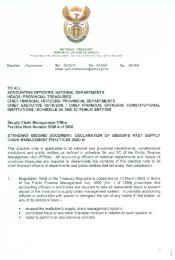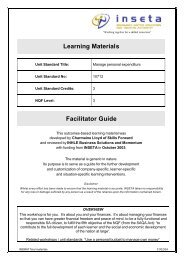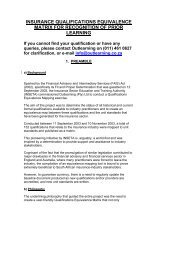SSP Brochure:Layout 1 - INSETA
SSP Brochure:Layout 1 - INSETA
SSP Brochure:Layout 1 - INSETA
Create successful ePaper yourself
Turn your PDF publications into a flip-book with our unique Google optimized e-Paper software.
additional staff. The technology also tends to limit the skills required of many (especially lower level) employees. Because many ofthe processes used in the industry have become systems-driven, over time this has led to skills deficiencies in the sector. New entrantsinto the industry learn to deal with the systems without understanding the underlying principles and processes. Skills developmenthas also become focused and narrow, leaving the industry without people with a broad, basic and thorough understanding of principleissues, practices and products. The lack of broad-based industry skills causes specific problems at junior and middle management level.e) Social factorsInequality and exclusion from financial servicesSouth African society is still marked by inequality and poverty with 67% of the adult population falling in the lower income categories– living standard measurement (LSM) 1-5. The majority of poor people are excluded from financial services in general and frominsurance products in particular. A study conducted in 2004 found that of the people falling in LSM 1-5, only 11% have a formal lifeinsurance policy, 15% have a funeral policy and 20% (6 mil.) use burial societies. 37 In the Financial Sector Charter, the insurance sectorhas committed itself to specific targets with regard to access to insurance and investment products. The achievement of these targetsdepends not only on the development of suitable and affordable products for this market, but also on effective delivery to the market.This includes overcoming the barriers referred to in Section (c) above.FraudFraud is an issue the industry has to deal with on an ongoing basis. According to recent research on the long-term and short-terminsurance components of the sector, fraud occurs among policyholders, internal staff and intermediaries. The short-term subsector(and presumably also the healthcare funders subsector) also has to deal with fraud among service providers. Some organisationsmaintain that staff and other fraud syndicates have penetrated the whole value chain. 38High levels of crime in South AfricaHigh crime levels in South Africa lead to increased insurance claims with consequent increases in premiums to cover costs. Overall,this has a negative impact on the insurance sector.High unemployment in South AfricaHigh unemployment means numerous people with no disposable income to spend on insurance products and a limited market inwhich to sell products. Limited growth in formal employment is matched by limited growth in the pension/provident fund investmentmarket. High retrenchments lead to an increase in pension and insurance payouts, which in turn has a negative impact on the sector’sinvestment base.Increase in life expectancyIncreased life expectancy impacts on the life insurance industry and the need to reinsure life portfolios, resulting in heightened demandfor higher level analytical, actuarial and financial skills in the reinsurance industry.HIV/AIDSHIV/Aids impacts negatively on the life and medical insurance sectors because of increased payouts, and it thus increases the overallcost of insurance and puts the products further out of the reach of the average South African. However, the sector believes that theimpact of HIV/AIDS has been largely mitigated through the adaptation of products. 39 The redesign of life insurance products toprovide for HIV/AIDS has affected reinsurance needs and has increased the need for higher level analytical, actuarial and financial skillsin the reinsurance subsector. 40At this stage, the effect of HIV/AIDs on the sector’s workforce is not a serious concern. Although no statistical information is availableon infection rates in this sector, the sector employs highly educated workers who are known to have lower infection rates and whowould probably have access to antiretroviral medication in the event of infection.1.5 ConclusionsThe insurance sector plays a key role in the South African economy as it provides and administers the main vehicles for savings. The sectorconsists on the one hand of a small number of relatively large insurance companies (which also administer a large portion of the pensionfunds in the country), collective investment managers and medical schemes and, on the other hand, numerous small intermediaries orbrokerages. The sector also includes a small number of self-administered pension funds (the rest of the funds use employees who areemployed by the fund members’ employers, and therefore the funds are not employers themselves).After a decline over the period 2002 to 2004 the long term insurance subsector regained momentum and is expected to continue to growsteadily over the next few years. The short term insurance and collective investment sectors are also expected to continue on a steadygrowth path. However, it is unlikely that employment will grow at the same pace. In the larger organisations productivity is increased through37 Napier, Mark, Provision of Financial Services in South Africa. Case study presented at the Services Experts Meeting, 3-4 February 2005. www//:finmark.org.za.38 PriceWaterhouseCoopers, Emerging Trends and Strategic Issues in South African Insurance, 2004.39 Comments of participants in the <strong>SSP</strong> development process, 2004.40 Views of some of the professional bodies that participated in <strong>SSP</strong> development process.<strong>INSETA</strong> Sector Skills Plan - page 13
















